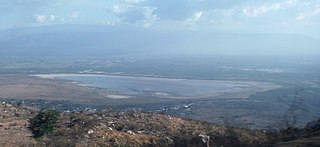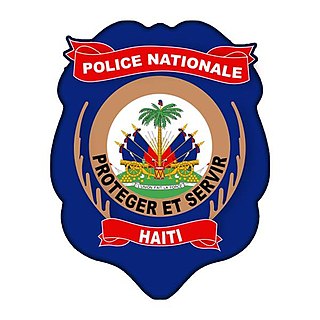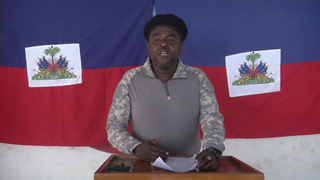Related Research Articles
The recorded history of Haiti began in 1492, when the European captain and explorer Christopher Columbus landed on a large island in the region of the western Atlantic Ocean that later came to be known as the Caribbean. The western portion of the island of Hispaniola, where Haiti is situated, was inhabited by the Taíno and Arawakan people, who called their island Ayiti. The island was promptly claimed for the Spanish Crown, where it was named La Isla Española, later Latinized to Hispaniola. By the early 17th century, the French had built a settlement on the west of Hispaniola and called it Saint-Domingue. Prior to the Seven Years' War (1756–1763), the economy of Saint-Domingue gradually expanded, with sugar and, later, coffee becoming important export crops. After the war which had disrupted maritime commerce, the colony underwent rapid expansion. In 1767, it exported indigo, cotton and 72 million pounds of raw sugar. By the end of the century, the colony encompassed a third of the entire Atlantic slave trade.

The Republic of Haiti comprises the western three-eighths of the island of Hispaniola, west of the Dominican Republic. Haiti is positioned east of the neighboring island of Cuba, between the Caribbean Sea and the North Atlantic Ocean.

A dead end, also known as a cul-de-sac, no through road or no exit road, is a street with only one inlet or outlet.

Ouest (French) or Lwès is one of the ten departments of Haiti. It is located in south-central Haiti, linking the Great-North and the Tiburon Peninsula.

Étang Saumâtre, is the largest lake in Haiti and the second largest lake in the Dominican Republic and Hispaniola, after Lake Enriquillo. It is also known as Lake Azuéi ; its Taíno name was Yainagua.

Toussaint Louverture International Airport is an international airport in Tabarre, a commune of Port-au-Prince in Haiti. The airport is currently the busiest in Haiti and is an operating hub for Sunrise Airways.

Trou Caïman, sometimes called Eau Gallée by locals, is a saltwater lake in Haiti known for its excellent birdwatching opportunities.
Croix-des-Bouquets is a commune in the Ouest department of Haiti. It is located 12.9 kilometers (8.0 mi) to the northeast of Haiti's capital city, Port-au-Prince. Originally located on the shore, it was relocated inland after the 1770 Port-au-Prince earthquake.

The Haitian National Police is the law enforcement and de facto police force of Haiti. It was created in 1995 to bring public security under civilian control as mandated in Haiti's constitution. As at 2023 the force has 9,000 active duty officers.
Plain of the Cul-de-Sac is a fertile lowland on the island of Hispaniola. It extends from southeastern Haiti into the southwestern Dominican Republic, where it is known as the Hoya de Enriquillo.
Crime in Haiti is investigated by the Haitian police. Since the late 2010s, the country has suffered from widespread gang warfare and civil unrest, including a massive prison breakout in 2024. It also suffers from extreme corruption and high levels of sexual violence.

The Indigenous Army, also known as the Army of Saint-Domingue was the name bestowed to the coalition of anti-slavery men and women who fought in the Haitian Revolution in Saint-Domingue. Encompassing both black slaves, maroons, and affranchis, the rebels were not officially titled the Armée indigène until January 1803, under the leadership of then-general Jean-Jacques Dessalines. Predated by insurrectionists such as François Mackandal, Vincent Ogé and Dutty Boukman, Toussaint Louverture, succeeded by Dessalines, led, organized, and consolidated the rebellion. The now full-fledged fighting force utilized its manpower advantage and strategic capacity to overwhelm French troops, ensuring the Haitian Revolution was the most successful of its kind.

Protests began in cities throughout Haiti on 7 July 2018 in response to increased fuel prices. Over time, these protests evolved into demands for the resignation of Jovenel Moïse, the then-president of Haiti. Led by opposition politician Jean-Charles Moïse, protesters stated that their goals were to create a transitional government, provide social programs, and prosecute allegedly corrupt officials. From 2019 to 2021, there were massive protests calling for the Jovenel Moïse government to resign. Moïse had come in first in the 2016 presidential election, for which voter turnout was 21%. The 2015 elections had been annulled due to fraud. On 7 February 2021, supporters of the opposition against Moïse allegedly attempted a coup d'état, leading to 23 arrests, as well as clashes between protestors and police.

From 2013 to 2020, around 15,000 Muslims were been besieged in PK5 district in Bangui, Central African Republic.
Events in the year 2021 in Haiti.

Jimmy Chérizier, nicknamed Barbecue, is a Haitian politician, criminal gang leader, former police officer, and warlord who is the head of the Revolutionary Forces of the G9 Family and Allies, abbreviated as "G9" or "FRG9", a federation of over a dozen Haitian gangs based in Port-au-Prince. Known for often making public appearances in military camouflage and a beret, he calls himself the leader of an "armed revolution". He had close connections with the Haitian Tèt Kale Party and was closely allied with former Haitian president Jovenel Moïse until his assassination in 2021. Considered the most powerful gang leader and war criminal in Haiti, he is also currently believed to be one of the country's de facto most powerful political figures. He is believed to be responsible for numerous large-scale massacres against civilians in the Port-au-Prince area.
The 400 Mawozo gang is the largest gang in Haiti, mainly based in Ganthier and in Port-au-Prince's Tabarre and Pétion-Ville. It largely consists of deportees, former leaders of opposition groups, former smugglers and police officers. In 2022, it aligned itself with "G-Pep" after its leader was extradited to the United States. It came to international attention in October 2021 when it kidnapped U.S. citizens acting as missionaries in Port-au-Prince, Haiti.

Since 2020, Haiti's capital, Port-au-Prince, has been the site of an ongoing gang war between two major criminal groups and their allies: the Revolutionary Forces of the G9 Family and Allies and the G-Pep. The Government of Haiti and Haitian security forces have struggled to maintain their control of Port-au-Prince amid this conflict, with gangs reportedly controlling up to 90% of the city by 2023. In response to the escalating gang fighting, an armed vigilante movement, known as bwa kale, also emerged, with the purpose of fighting the gangs. On 2 October 2023, United Nations Security Council Resolution 2699 was approved, authorizing a Kenya-led "multinational security support mission" to Haiti.
The Bel Air massacre was a series of shootings, extrajudicial killings, and massacres that took place in the Bel Air neighborhood of Port-au-Prince, Haiti between August 2020 and May 2021. Between August and October 2020, G9 An Fanmi e Alye members attacked Bel Air residents, with continued attacks by the affiliated Krache Dife gang. The massacres died down until March 31, whenever renewed attacks began, sparking battles with Bel Air residents who defended themselves.
References
- ↑ Crime, InSight (2022-03-23). "400 Mawozo". InSight Crime. Retrieved 2023-08-06.
- 1 2 3 4 5 6 7 8 9 10 11 12 National Human Rights Defense Network (May 10, 2022). "Violent clashes between armed gangs: RNDDH demands protection of the Haitian population" (PDF). National Human Rights Defense Network. Retrieved August 6, 2023.
- 1 2 3 4 5 6 7 8 9 10 11 12 13 National Human Rights Defense Network (June 27, 2022). "Carnage at La Plaine du Cul-de-Sac: The survivors demand the authorities" (PDF). National Human Rights Defense Network. Retrieved August 6, 2023.
- ↑ "Chen Mechan and 400 Mawozo Gang Confrontations and Ecuadorian Provincial States of Emergency". CTG. 2022-05-06. Retrieved 2023-08-06.